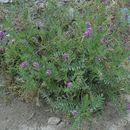Cyclicity
(
Anglèis
)
fornì da Plants of Tibet
Flowering and fruiting from June to September.
Diagnostic Description
(
Anglèis
)
fornì da Plants of Tibet
Oxytropis proboscidea is close relative of Oxytropis savellanica, but differs from the latter in its peduncle 4-15 cm (vs. 1.8-3.5 cm), to 2 times as long as leaves (vs. less than 2 times as long as leaves), leaves 2-12 cm (vs. 1.5-3 cm).
Distribution
(
Anglèis
)
fornì da Plants of Tibet
Oxytropis proboscidea is occurring in Gansu, Xinjiang, Xizang, Yunnan of China.
Evolution
(
Anglèis
)
fornì da Plants of Tibet
Phylogenetic relationships of Astragalus L. (Fabaceae), and its closest relatives within tribe Galegeae were inferred from nucleotide sequences of the plastid matK gene and nuclear rDNA internal transcribed spacer region (Wojciechowski, 2005). Results shown the matK data provides better resolution and stronger clade support for relationships among Astragalus and traditionally related genera than nrDNA ITS. Astragalus sensu stricto plus the genus Oxytropis are strongly supported as sister to a clade composed of strictly Old World (African, Australasian) genera such as Colutea, Sutherlandia, Lessertia, Swainsona, and Carmichaelia, plus several morphologically distinct segregates of Eurasian Astragalus.
General Description
(
Anglèis
)
fornì da Plants of Tibet
Herbs, 3-17 cm tall, acaulescent, from a multi-headed caudex, densely cinereous-pubescent. Stipules ovate, membranous, densely sericeous with long trichomes, free from petiole, basally connate. Leaves 2-12 cm, with 9-19 leaflets; rachis with small glands; leaflet blades oblong to oblong-lanceolate, 3-10 mm long, 1.5-3 mm wide, sericeous with spreading long trichomes. Racemes compact, 6-10-flowered; peduncle 4-15 cm, equalling to much longer than leaves, with dense white and black incurved trichomes; bracts linear, slightly shorter than calyx tube, with sparse white and black trichomes. Calyx 4-6 mm, with dense black or white trichomes mixed with black long trichomes; lobes lanceolate, shorter than tube. Corolla purple, bluish purple, or seldom white; standard 5-9 mm long, ca. 5 mm wide, lamina orbicular, apex emarginate to rounded; wings ca. 7 mm, lamina obovate to oblong, apex emarginate; keel ca. 6 mm, beak subtriangular, very short. Legume shortly stipitate; body ovoid to oblong-ovoid, 5-7 mm long, 4-6 mm wide, inflated, membranous, 1-locular, with spreading dense white long and black short trichomes, septum absent, adaxial suture emarginate, beak erect.
Genetics
(
Anglèis
)
fornì da Plants of Tibet
The chromosomal number of Oxytropis proboscidea is 2n = 16 (Wang et al., 1996).
Habitat
(
Anglèis
)
fornì da Plants of Tibet
Growing in desert grasslands, gravelly areas, lake shores, sunny dry slopes, flood plains, cold meadows, sand dunes; 4100-5300 m.

